|
Strain Name
|
C57BL/6N-Tgfb1tm2(TGFB1)Bcgen/Bcgen
|
Common Name
|
B-hTGFB1 mice
|
|
Background
|
C57BL/6N
|
Catalog number
|
112245
|
|
Aliases
|
TGFB1(CED, LAP, DPD1, TGFB, IBDIMDE, TGFbeta, TGF-beta1)
|
mRNA expression analysis
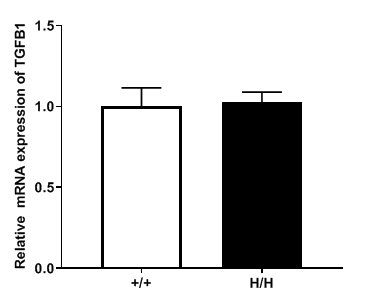
Strain specific analysis of TNFR2 gene expression in wild-type C57BL/6 mice and hTGFB1 mice by RT-qPCR. The mRNA expression of hTGFB1 in homozygous B-hTGFB1 mice (H/H) was similar to those in the wild-type C57BL/6 mice (+/+), demonstrating that introduction of hTGFB1 in place of its mouse counterpart does not change the expression level of TGFB1 mRNA.
Protein expression analysis
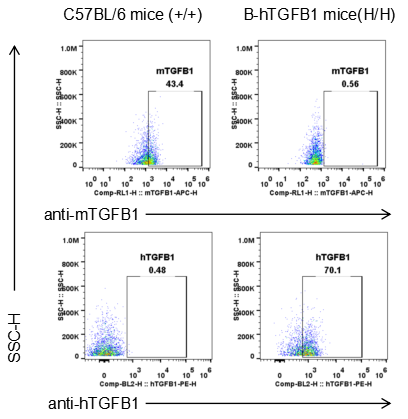
Strain specific TGFB1 expression analysis in homozygous B-hTGFB1 mice by flow cytometry. Splenocytes were collected from wild-type C57BL/6 mice (+/+) and homozygous B-hTGFB1 mice (H/H), and analyzed by flow cytometry with species-specific anti-TGFB1 antibody. Mouse TGFB1 was detectable in wild-type mice. Human TGFB1was exclusively detectable in homozygous B-hTGFB1 but not in wild-type mice.
Analysis of leukocytes cell subpopulation in spleen

Analysis of spleen leukocyte subpopulations by FACS. Splenocytes were isolated from female C57BL/6 and homozygous B-hTGFB1 mice(n=3, 6-week-old). Flow cytometry analysis of the splenocytes was performed to assess leukocyte subpopulations. A. Representative FACS plots. Single live cells were gated for the CD45+ population and used for further analysis as indicated here. B. Results of FACS analysis. Percent of T cells, B cells, NK cells, dendritic cells, granulocytes, monocytes and macrophages in homozygous B-hTGFB1 mice were similar to those in the C57BL/6 mice, demonstrating that introduction of hTGFB1 in place of its mouse counterpart does not change the overall development, differentiation or distribution of these cell types in spleen. Values are expressed as mean ± SEM.
Analysis of T cell subpopulation in spleen
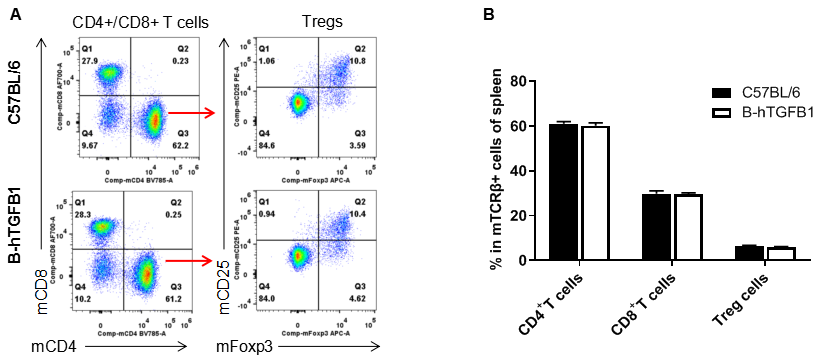
Analysis of spleen T cell subpopulations by FACS. Splenocytes were isolated from female C57BL/6 and homozygous B-hTGFB1 mice(n=3, 6-week-old). Flow cytometry analysis of the splenocytes was performed to assess leukocyte subpopulations. A. Representative FACS plots. Single live CD45+ cells were gated for CD3+ T cell population and used for further analysis as indicated here. B. Results of FACS analysis. The percent of CD8+ T cells, CD4+ T cells, and Tregs in homozygous B-hTGFB1 mice were similar to those in the C57BL/6 mice, demonstrating that introduction of hTGFB1 in place of its mouse counterpart does not change the overall development, differentiation or distribution of these T cell subtypes in spleen. Values are expressed as mean ± SEM.
Analysis of leukocytes cell subpopulation in lymph node
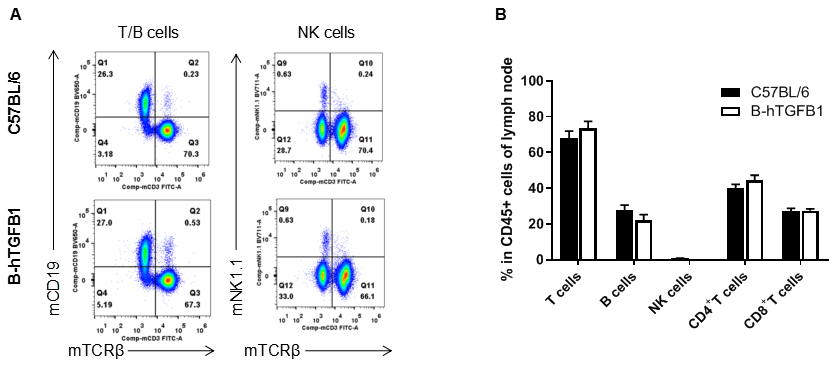
Analysis of lymph node leukocyte subpopulations by FACS. Leukocytes were isolated from female C57BL/6 and homozygous B-hTGFB1 mice(n=3, 6-week-old). Flow cytometry analysis of the leukocytes was performed to assess leukocyte subpopulations. A. Representative FACS plots. Single live cells were gated for CD45+ population and used for further analysis as indicated here. B. Results of FACS analysis. The percent of T cells, B cells and NK cells in homozygous B-hTGFB1 mice were similar to those in the C57BL/6 mice, demonstrating that introduction of hTGFB1 in place of its mouse counterpart does not change the overall development, differentiation or distribution of these cell types in lymph node. Values are expressed as mean ± SEM.
Analysis of T cell subpopulation in lymph node
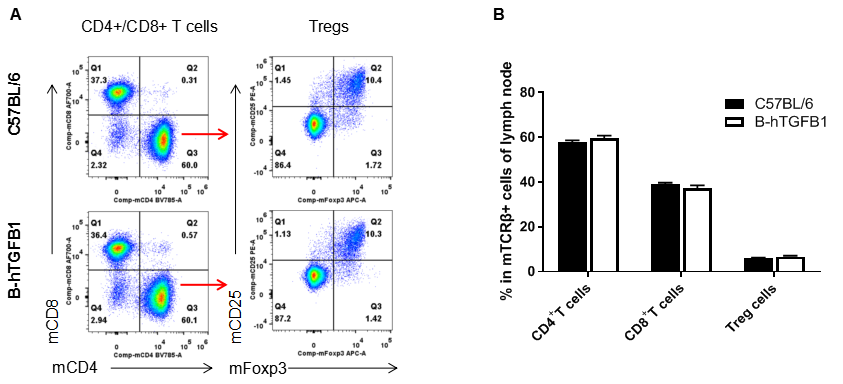
Analysis of lymph node T cell subpopulations by FACS. Leukocytes were isolated from female C57BL/6 and homozygous B-hTGFB1 mice(n=3, 6-week-old). Flow cytometry analysis of the splenocytes was performed to assess leukocyte subpopulations. A. Representative FACS plots. Single live cells were gated for the CD45+ population and used for further analysis as indicated here. B. Results of FACS analysis. The percent of CD8+ T cells, CD4+ T cells, and Tregs in homozygous B-hTGFB1 mice were similar to those in the C57BL/6 mice, demonstrating that introduction of hTGFB1 in place of its mouse counterpart does not change the overall development, differentiation or distribution of these T cell subtypes in lymph node. Values are expressed as mean ± SEM.
Analysis of leukocytes cell subpopulation in blood

Analysis of blood leukocyte subpopulations by FACS. Blood were isolated from female C57BL/6 and homozygous B-hTGFB1 mice(n=3, 6-week-old). Flow cytometry analysis of the splenocytes was performed to assess leukocyte subpopulations. A. Representative FACS plots. Single live cells were gated for the CD45+ population and used for further analysis as indicated here. B. Results of FACS analysis. Percent of T cells, B cells, NK cells, dendritic cells, granulocytes, monocytes and macrophages in homozygous B-hTGFB1 mice were similar to those in the C57BL/6 mice, demonstrating that introduction of hTGFB1 in place of its mouse counterpart does not change the overall development, differentiation or distribution of these cell types in blood. Values are expressed as mean ± SEM.
Analysis of T cell subpopulation in blood
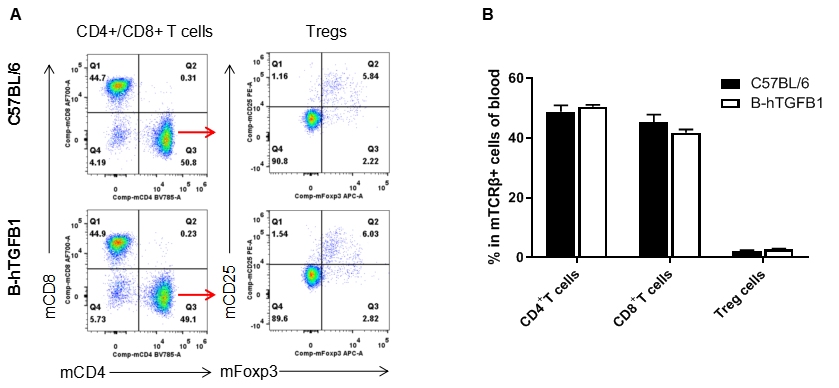
Analysis of blood T cell subpopulations by FACS. Blood were isolated from female C57BL/6 and homozygous B-hTGFB1 mice(n=3, 6-week-old). Flow cytometry analysis of the splenocytes was performed to assess leukocyte subpopulations. A. Representative FACS plots. Single live CD45+ cells were gated for CD3+ T cell population and used for further analysis as indicated here. B. Results of FACS analysis. The percent of CD8+ T cells, CD4+ T cells, and Tregs in homozygous B-hTGFB1 mice were similar to those in the C57BL/6 mice, demonstrating that introduction of hTGFB1 in place of its mouse counterpart does not change the overall development, differentiation or distribution of these T cell subtypes in blood. Values are expressed as mean ± SEM.
Antibody binding assay
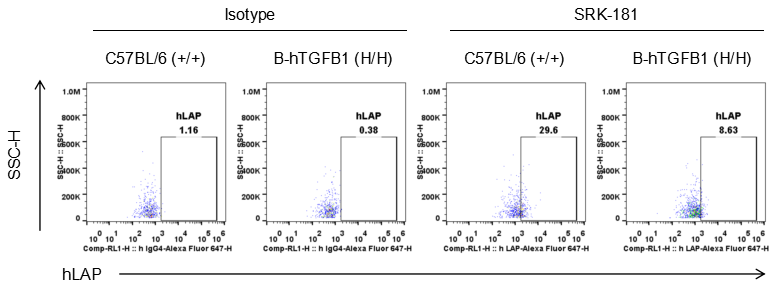
Analysis of platelets of B-hTGFB1 mice by FACS. Blood were isolated from female B-hGFB1 mice. Flow cytometry analysis of the platelets was performed to assess human LAP expression. Human LAP expression was detectable on wild-type C57BL/6 mice and homozygous B-hTGFB1 mice.
Combination therapy of anti-mouse PD-1 antibody and anti-human TGFβ1 antibody
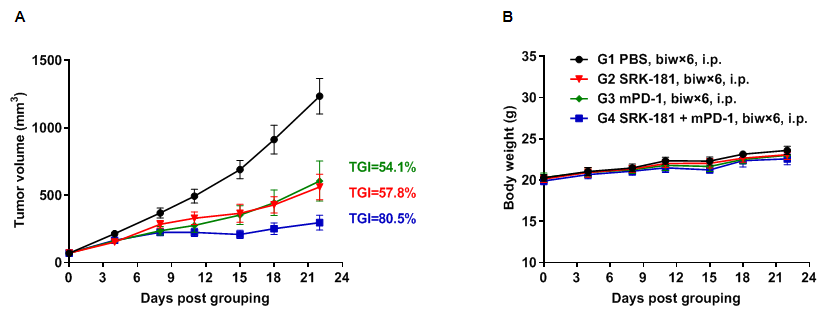
Antitumor activity of anti-mouse PD-1 antibody combined with anti-human TGFβ1 antibody in B-hTGFB1 mice. (A) Anti-mouse PD-1 antibody combined with anti-human TGFβ1 antibody (in house) inhibited MC38 tumor growth in B-hTGFB1 mice. Murine colon cancer MC38 cells (5E5) were subcutaneously implanted into homozygous B-hTGFB1 mice (female, 7-week-old, n=6). Mice were grouped when tumor volume reached approximately 50~80 mm3, at which time they were treated with anti-mouse PD-1 antibody and anti-human TGFβ1 antibody with doses and schedules indicated in panel A. (B) Body weight changes during treatment. As shown in panel A, combination of anti-mPD-1 antibody and anti-human TGFβ1 antibody were efficacious in controlling tumor growth in B-hTGFB1, demonstrating that the B-hTGFB1 mice provide a powerful preclinical model for in vivo evaluation of anti-human TGFB1 antibodies. Values are expressed as mean ± SEM.






















 京公网安备:
京公网安备: